TTK is also supported on other operating systems:
· Windows installation instructions (from source);
· MacOS installation instructions (from source).
These specific notes describe the installation procedure for a Ubuntu Linux 24.04 operating system (but the process should be very similar for other Linux distributions). A video from our tutorial page also shows how to proceed on a step-by-step basis.
If you are an advanced user and you do not wish to install ParaView (TTK's main user interface), you still have the possibility to install TTK without ParaView support (although we highly recommend to activate it).
In that case, simply download TTK as describded in section 1, install the dependencies as detailed in section 2 and finally, directly jump to section 6 ("Configuring, building and installing TTK").
Examples showing how to use TTK libraries from your own VTK code can be found on this page.
If you are an advanced user and you do not even wish to install VTK, you still have the possibility to install TTK without VTK support (although we highly recommend to activate it).
In that case, simply download TTK as describded in section 1, install the optional dependencies as detailed in section 2 and finally, directly jump to section 6 ("Configuring, building and installing TTK").
Examples showing how to use TTK libraries from your own C++ code can be found on this page.
Most users will want to activate TTK's ParaView support.
The remainder of these notes describe the installation of the version 1.3.0 of TTK along with the version 5.13.0 of ParaView. Other versions of either software packages may require slight variations in the installation procedure. For earlier versions of both software packages, you may want to check out previous versions of our installation notes:
· TTK 1.2.0 with ParaView 5.11.1,
· TTK 1.1.0 with ParaView 5.10.1,
· TTK 1.0.0 with ParaView 5.9.1,
(...)
1. Downloads
TTK builds on top of ParaView for its main user interface. Thus, you will first need to download ParaView's source code. Note that TTK plugins for ParaView will only work with a version of ParaView compiled from source. Thus, if you already installed ParaView with a binary copy, you may need to un-install it before proceeding. Next, download TTK from our download page.
2. Installing the dependencies
Several dependencies will need to be installed in order to compile ParaView and TTK from source. Please enter the following commands (omit the$ character) in a terminal to install them (please see
the documentation of your package manager if your operating system is not
Ubuntu Linux):
$ sudo apt install -y cmake-qt-gui ninja-build libboost-system-dev libopengl-dev libxcursor-dev
$ sudo apt install -y qtbase5-dev qtchooser qt5-qmake qtbase5-dev-tools qttools5-dev qtxmlpatterns5-dev-tools libqt5x11extras5-dev libqt5svg5-dev
qttools5-dev libqt5x11extras5-dev
libqt5svg5-dev qtxmlpatterns5-dev-tools
Note that these commands will also trigger the installation of the (numerous) dependencies of these components.
Optional dependencies
In order to enjoy the complete set of TTK features, we also recommend to install the following, optional dependencies:· embree (in-situ ray-tracing support for TTK's cinema features, version 3.4.0 or later). See the following page for installation instructions.
· eigen (for scalar field design, version 3.3.7 or later). Under Ubuntu Linux 24.04, enter the following command:
$ sudo apt install -y libeigen3-dev
· graphviz (for graph drawing features, version 2.40.1 or later). Under Ubuntu Linux 24.04, enter the following command:
$ sudo apt install -y libgraphviz-dev
· qhull (for dimension reduction features, version 2020 or later). Under Ubuntu Linux 24.04, enter the following command:
$ sudo apt install -y libqhull-dev
· scikit-learn (for data reduction features, version 0.19.0 or later). Under Ubuntu Linux 24.04, enter the following command:
$ sudo apt install -y python3-sklearn
· Spectra (for the computation of the eigenfunctions of the Laplace-Beltrami operator, version 0.8.1 or later). See the following page for installation instructions.
· sqlite (for cinema query features, version 3.24.0 or later). Under Ubuntu Linux 24.04, enter the following command:
$ sudo apt install -y libsqlite3-dev
· libtorch (for neural network support, version 2.2.0 or later). See the following page for installation instructions.
· Websocketpp (for remote control features). Under Ubuntu Linux 24.04, enter the following command:
$ sudo apt install -y libwebsocketpp-dev
· ZFP (for advanced compression support, version 0.5.4 or later). See the following page for installation instructions.
· zlib (for further compression support, version 1.2.11 or later). Under Ubuntu Linux 24.04, enter the following command:
$ sudo apt install -y zlib1g-dev
It has also been reported that the following packages may need to be installed under Fedora (as of version 30):
lz4,
protobuf,
pugixml,
cgnslib-devel,
zfp-devel.
3. Preparing the sources
Move the tarballs to a working directory (for instance called~/ttk) and decompress them by entering the following commands in
a terminal (this assumes that you downloaded the tarballs to the
~/Downloads directory):$ mkdir ~/ttk$ mv ~/Downloads/ParaView-v5.13.0.zip ~/ttk/$ mv ~/Downloads/ttk-1.3.0.zip ~/ttk/$ cd ~/ttk$ unzip ParaView-v5.13.0.zip$ unzip ttk-1.3.0.zipYou can delete the tarballs after the source trees have been decompressed by entering the following commands:
$ rm ParaView-v5.13.0.zip$ rm ttk-1.3.0.zip
4. Patching the ParaView source tree
In order to enjoy the complete set of TTK features, we recommend at this stage to patch the ParaView source tree. This step is optional. To proceed, go to the patch directory and apply it as follows:$ cd ~/ttk/ttk-1.3.0/paraview/patch$ ./patch-paraview-5.13.0.sh
~/ttk/ParaView-v5.13.0/
5. Configuring, building and installing ParaView
a) Configuration
To enter the configuration menu of ParaView's build, enter the following commands:$ cd ~/ttk/ParaView-v5.13.0/$ mkdir build$ cd build$ cmake-gui ../The configuration window opens. Click on the "Configure" button to proceed. Select the "Ninja" generator. Once the configuration is finished, you may want to enable additional build options (OSPRay, MPI, etc) to your liking (see the ParaView build documentation for further details). Note that certain options require the installation of additional dependencies.
Next, click on the "Generate" button and close the configuration window when the generation is completed.
Note to Linux Mint users
It has been reported that the following CMake variables need to be updated as follows (as of version 19): · CMAKE_C_FLAGS=-luuid · CMAKE_CXX_FLAGS=-luuid
b) Build
Now you can start the compilation process by entering the following command (this will take a LONG time):$ ninjac) Installation
Once the build is finished, enter the following command to install your build of ParaView on your system:$ sudo ninja install
6. Configuring, building and installing TTK
a) Configuration
To enter the configuration menu of TTK's build, enter the following commands:$ cd ~/ttk/ttk-1.3.0/$ mkdir build$ cd build$ cmake-gui ../The configuration window opens. Click on the "Configure" button to proceed. Select the "Ninja" generator. At this stage, under Linux, TTK's build should be automatically configured correctly by default and Linux users can click on the "Generate" button.
Once the generation is completed, close the configuration window.
If you are an advanced user and you do not wish to activate TTK's ParaView support, set the CMake variable
TTK_BUILD_PARAVIEW_PLUGINS to
OFF.
Examples showing how to use TTK libraries from your
own VTK code can be found
on this page.If you are an advanced user and you do not even wish to activate TTK's VTK support, set the CMake variables
TTK_BUILD_STANDALONE_APPS and
TTK_BUILD_VTK_WRAPPERS to OFF.
Examples showing how to use TTK libraries from your own
C++ code can be found
on this page.b) Build
Now you can start the compilation process by entering the following command (this will take a LONG time):$ ninjac) Installation
Once the build is finished, enter the following command to install your build of TTK on your system:$ sudo ninja install
Note that, in addition to the installation of TTK plugins for ParaView,
the above command also installed a collection of standalone TTK programs
that
can be used outside of ParaView,
either as command line tools or VTK-based graphical user interfaces. To list
them, enter the following commands (this assumes that you did not modify the
default TTK installation path, /usr/local/):
$ ls /usr/local/bin/*Cmd
$ ls /usr/local/bin/*Gui
7. Setting up environment variables
At this point, for an optimal user experience, we recommend users to define the following environment variables (in particular, when using TTK with python). Under Ubuntu Linux, this can be done by entering the following commands (omit the$ character):$ echo "export LD_LIBRARY_PATH=${LD_LIBRARY_PATH}:/usr/local/lib" >> ~/.bashrc$ echo "export PV_PLUGIN_PATH=${PV_PLUGIN_PATH}:/usr/local/bin/plugins/"
>> ~/.bashrc$ echo "export PYTHONPATH=${PYTHONPATH}:/usr/local/lib/python3.12/site-packages/" >> ~/.bashrc$ source ~/.bashrcNote that if you decided to change the default installation path of ParaView and TTK, you will need in the above commands to replace
/usr/local by your custom installation path.
8. Checking your TTK installation
If you applied all the above steps successfully (including step 4), you can now open a terminal and type the following command to load your TTK-patched ParaView:$ paraviewAt this point, you should see the following TTK startup screen:
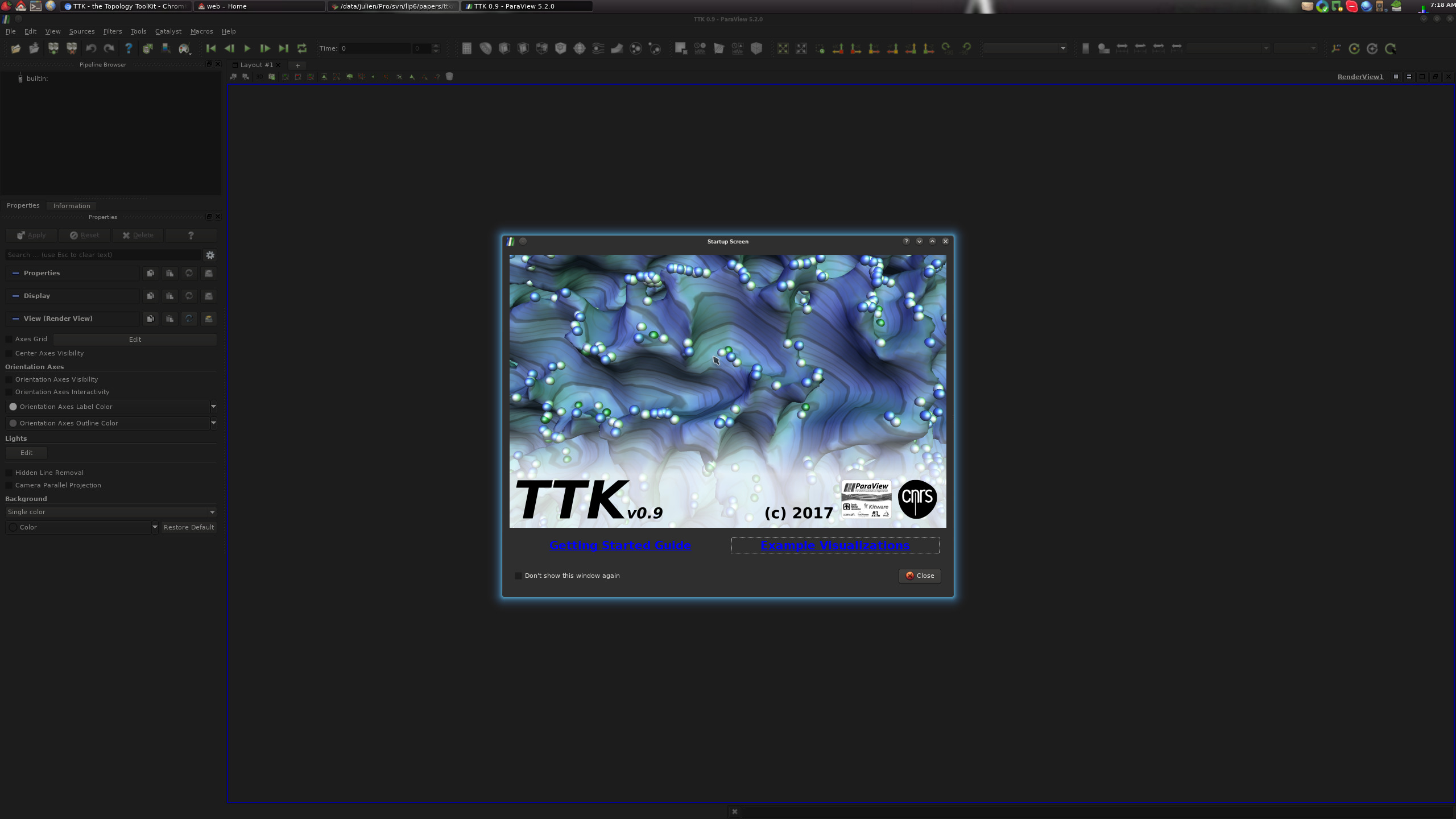
On this screen, clicking on the "Example Visualizations" link should bring you to the TTK built-in example screen:
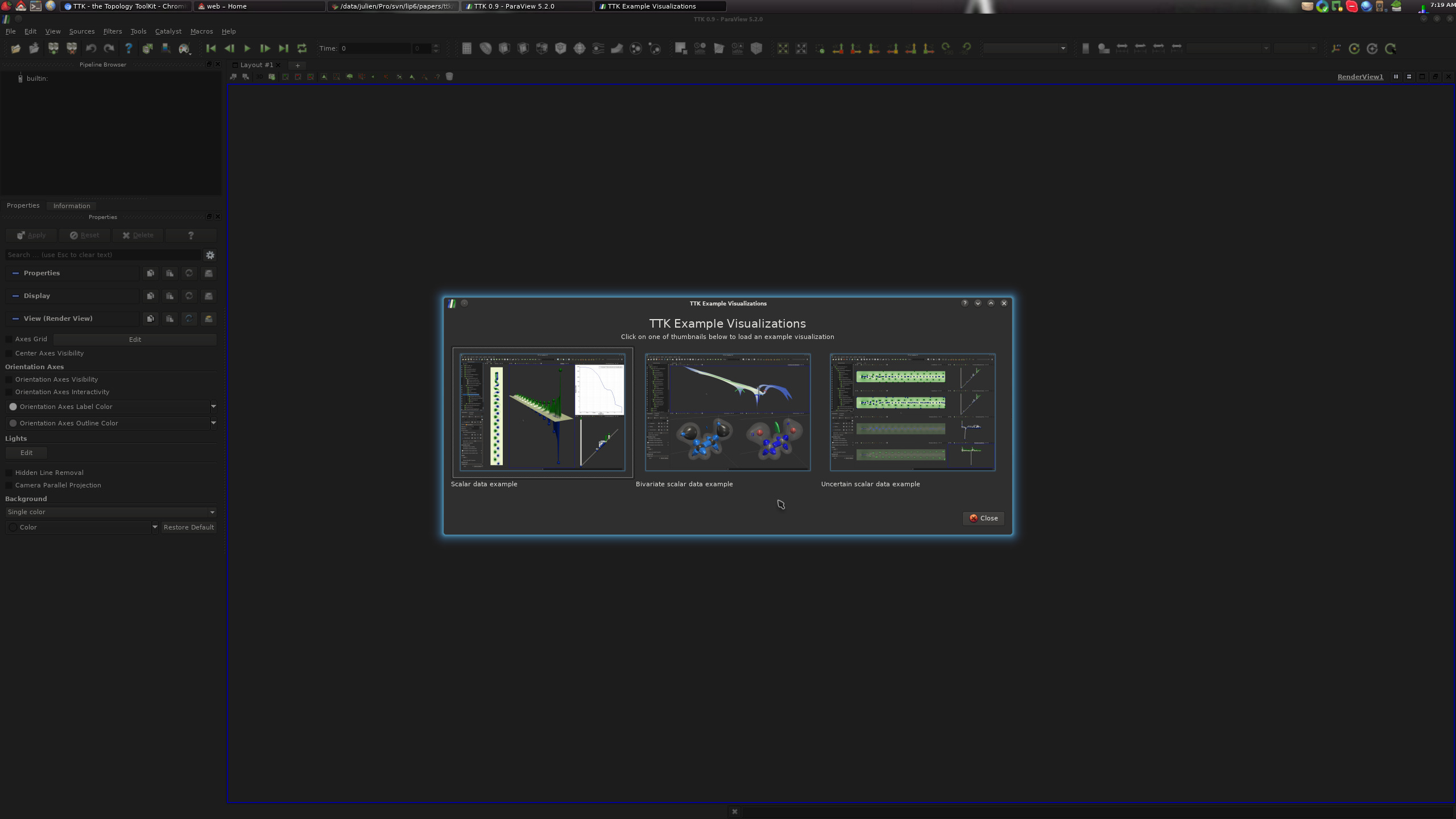
From there, clicking on one of the three buttons should generate one of the following three visualizations:
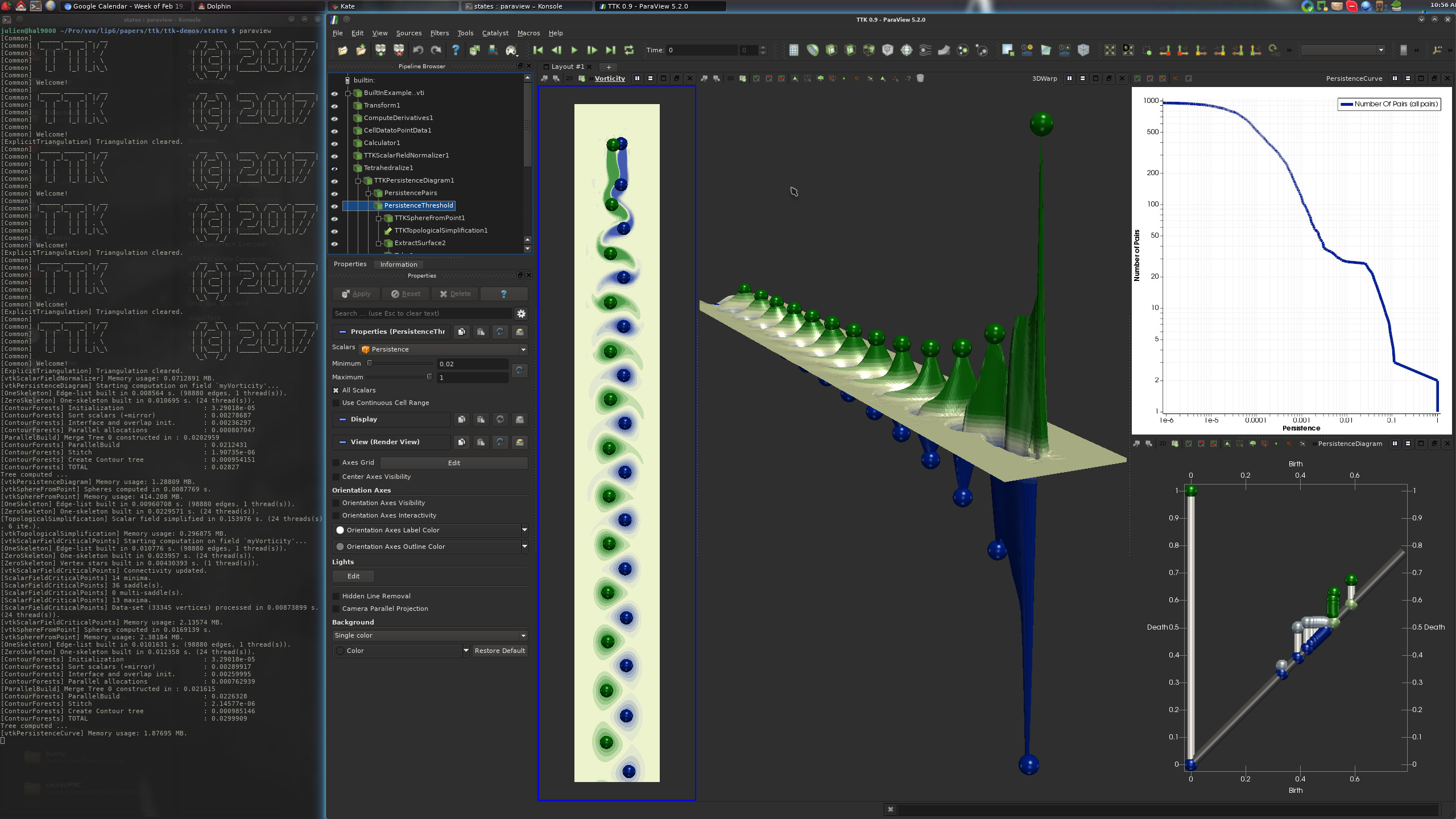
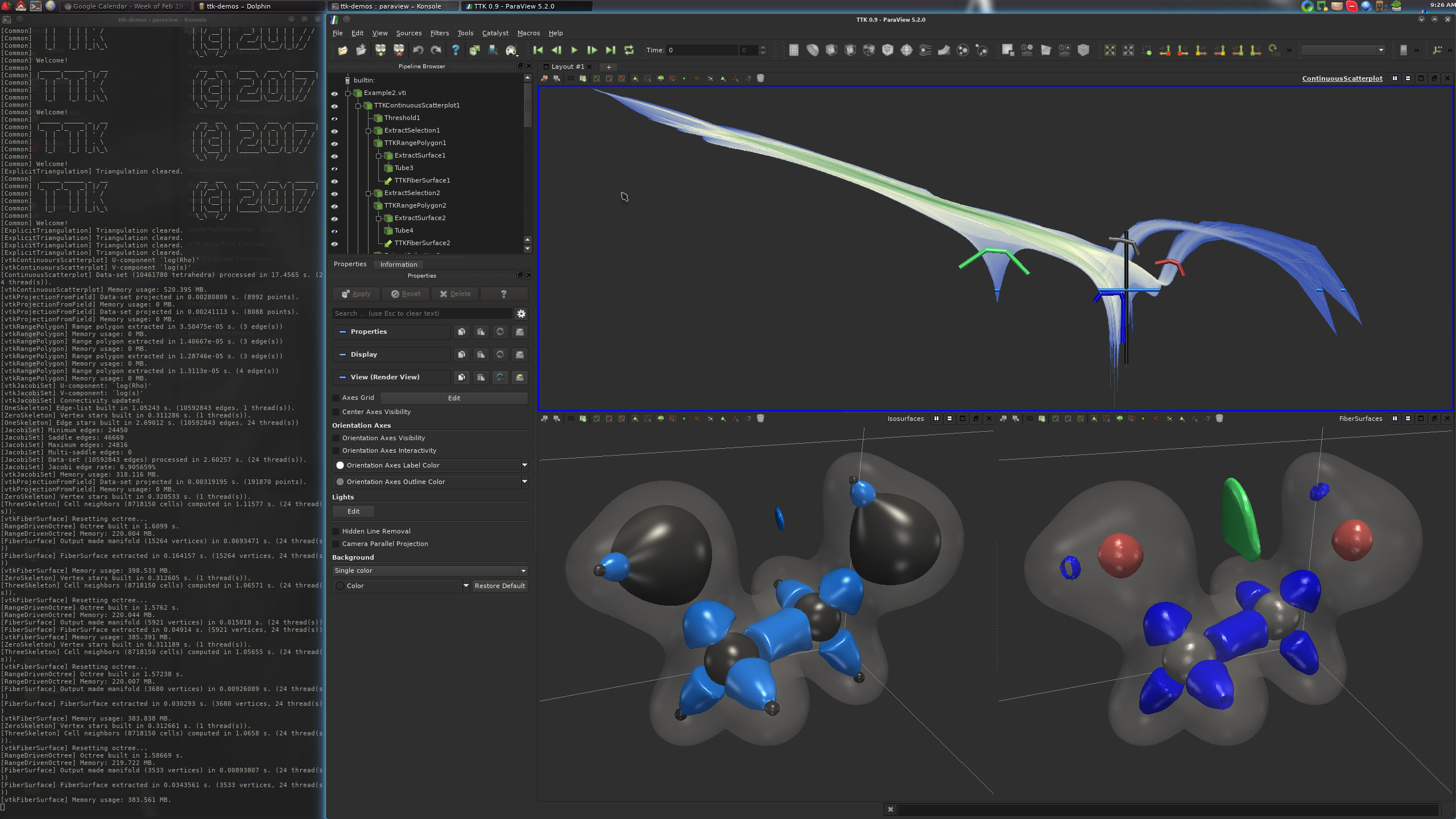
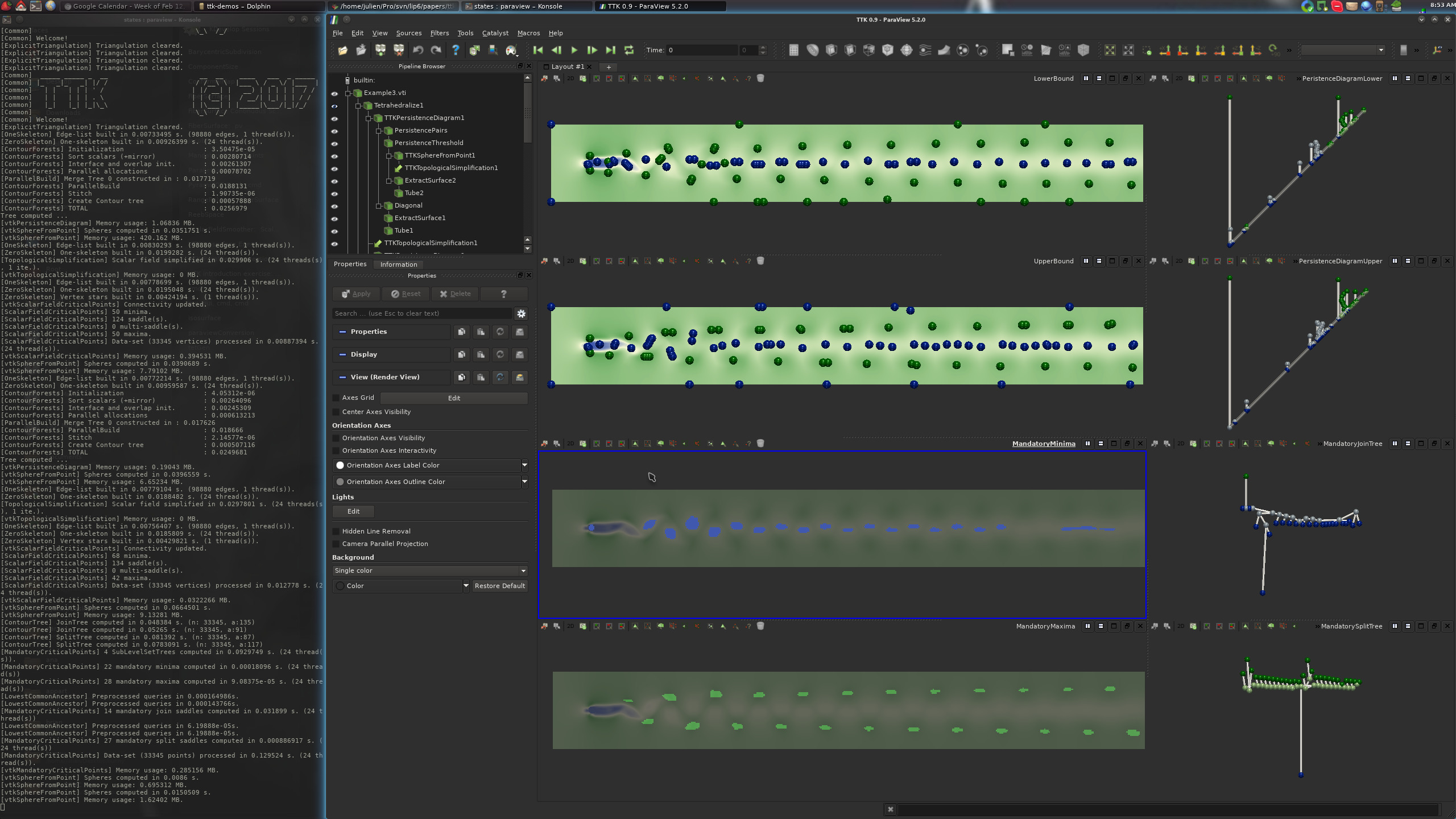
If this is the case, congratulations!
You have just successfully installed TTK on your system!
If you have not applied the optional step 4 of this installation procedure, certain TTK features will not be accessible from ParaView and the above built-in examples will not be available in your ParaView build. However, most of TTK features should still work as expected.
Now, please visit our tutorial page to watch video tutorials showing how to use TTK with ParaView with concrete examples and how to use it from your own Python or C++ code or how to extend TTK by writing up your own module!